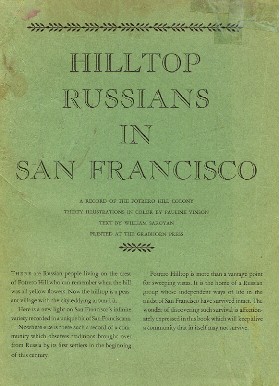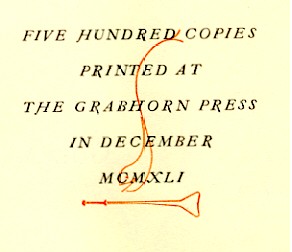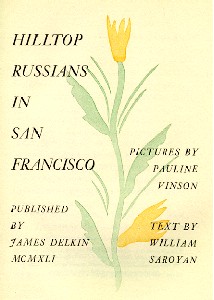Hilltop Russians in San Francisco
A Record of the Potrero Hill Colony
| Thirty Illustrations in Color by Pauline Vinson [born 1915] Text by William Saroyan Printed at the Grabhorn Press (1941) THERE are Russian people living on the crest of Potrero Hill who can remember when the hill was all yellow flowers. Now the hilltop is a peasant village with the city eddying around it. |
 |
  |
Copyright 1941 by James Ladd Delkin, Stanford University, California The water-color reproductions of the work of Pauline Vinson of the Art Project in San Francisco are used by permission of Work Projects Administration.
INTRODUCTION PREFACE TO THE PICTURES Though the new generation is unquestionably American, and speak of their parents as being "old fashioned," the discipline and authority of the patriarchal tradition is yet alive. The Hilltop still retains both the aspect and the atmosphere of a peasant village. Only with the morning and evening rush of the younger workers is the slow temp broken--and then only briefly. At first sight the architecture may seem drab and commonplace because in building, these people followed the haphazard local forms of the day. Nevertheless, they added something of their own in the quality of a foreign accent--difficult to point to specifically, but clearly perceptible. With the life which quietly animates these streets and buildings, they do become quite as foreign as the people themselves. |
See pictures in groups of 6: 1-6, 7-12, 13-18, 19-24, 25-30
Index:
- INTRODUCTION by Willian Saroyan (with historical notes)
- WAITING FOR THE BUS Most of the men work in the nearby industrial district.
- THE CITY BELOW AND BEYOND
- SITTING IN THE SUN is part of the hilltop's unhurried routine.
- THE RETIRED ENJOY THEIR LEISURE
- CONVERSATIONS at De Haro and Twenty-Second Streets
- AFTER CHURCH on Sunday mornings news and greetings are exchanged
- MOLOKAN MADONNA
- A STREET CORNER DISCUSSION though rarely demonstrative, is punctuated with slow wide gestures.
- RHODE ISLAND STREET
- THE MOLOKAN WOMAN when out of doors, even in their own backyard, must keep her head covered
- WESTERN SIDE OF THE HILL
- HOME FROM THE COUNTRY Some of the men do seasonal agricultural work in the bay area.
- THE MOLOKAN GIRL When she goes down town or to school she will dress and act like any other American girl.
- GRANDMOTHER ARRIVES
- THE EASTERN SIDE OF THE HILL, warm and sheltered, looks over San Francisco Bay.
- A VISITING DUKHOBOR There are no Dukhobors living on Potrero Hill although the two sects have much in common. The stolid Molokan, however, regards their more demonstrative religious practice and comparative intellectualism with suspicion.
- A BAG OF SUN FLOWER SEEDS attract both old and young.
- COSTUME OF COTTON PRINT
- A STEAM BATH, housed in a rough sturdy little building with a large metal chimney, is part of every backyard.
- A SATURDAY NIGHT BARBEQUE over the hot embers raked from the primitive steam bath furnace.
- A CARPENTER
- OLD FRIENDS MEET as former members of the colony return from the country with produce for sale.
- TO MARKET
- LANDLORD
- WEDDING GUESTS
- THE MOLOKAN CHURCH It is a large barn-like structure with hardly any embellishments. The services are attended by hundreds--almost all in peasant costume. Sunday mornings are very colorful as the people converge here from all parts of the hill. After the services they move slowly away, exchanging greetings, and talking in small groups.
- A WEDDING is always a community affair. A great throng, led by the bride and groom, moves slowly from the bride's house to the church singing traditional songs. The actual ceremony is long and tedious with solemn chanting and exhortation.
- THE HOLY JUMPERS' CHURCH It is an ordinary small house with hardly a thing to distinguish it. During the services the small congregation stands in a circle, or rather, an oval with the men on one side and the women on the other. A patriarch reads, prays and leads the chanting and singing. All take part in a slow stomping during the chanting and singing-- thence the name of the sect.
- AT THE WEDDING RECEPTION which follows the ceremony there is simple peasant feasting--but with no drinking or dancing. An incongruous not is struck when the bride and groom break away in a shining new car (generally) festooned with the usual tin cans and old shoes. The old people remain with their teas and cakes while the younger ones drift off to celebrate in a more American manner.
- A MOLOKAN FUNERAL has little of the lugubriousness attendant upon the ordinary funeral. Brightly dressed little girls bearing flowers lead the procession. The casket is open and the cover borne above the heads of four men. The relations and friends stay close to the deceased while the whole colony follows along informally. There is dignity but very little evidence of grief and the only funereal note is in the intermittent chanting. Just previous to interment the procession follows the route most frequented in life by the departed.
Back to Hilltop Russians
Back to Molokan and Jumper History
Back to Molokan and Jumper NEWS
Back to Molokans and Jumpers Around the World